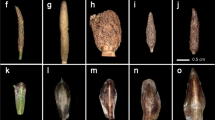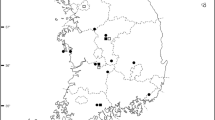Abstract
Analysis of the chromosomal status of the 12 taxa ofSedum sectionGormania reveals a euploid series ofn = 15, 30, and 45. Although plants of all taxa are self-compatible in varying degrees, those of the narrow endemics exhibit a high level of self-compatibility while the plants of all but one of the more widely distributed taxa tend to be weakly self-compatible or rarely selfincompatible. The narrow endemics include four diploids, all putative relicts, and two tetraploids. The widely distributed taxa include four diploids, one tetraploid, and one hexaploid. The differences in ploidal level and the degree of self-compatibility are assessed with respect to their possible roles in the evolutionary history of sectionGormania.
Similar content being viewed by others
Literature Cited
Arroyo, M. T. K. 1973. A taximetric study of infraspecific variation in autogamousLimnanthes floccosa (Limnanthaceae). Brittonia 25: 177–191.
Baker, H. G. 1955. Self-compatibility and establishment after long-distance dispersal. Evolution 9: 347–348.
— 1967. The evolution of weedy taxa in theEupatorium microstemon species aggregate. Taxon 16: 293–300.
Baldwin, E. M. 1976. Geology of Oregon. Revised Edition. Kendall/Hunt Publishing Company, Dubuque, Iowa.
Clausen, R. T. 1975.Sedum of North America north of the Mexican plateau. Cornell University Press, Ithaca.
Denton, M. F. 1978. Two new taxa ofSedum sectionGormania (Crassulaceae) endemic to the Trinity Mountains in California. Brittonia 30: 233–238.
—. 1979. Factors contributing to evolutionary divergence and endemism inSedum sectionGormania (Crassulaceae). Taxon 28: 149–155.
Fedorov, A. A. 1969. Chromosome numbers of flowering plants. V. L. Komarov Botanical Institute, Leningrad.
Fryxell, P. A. 1957. Mode of reproduction in higher plants. Bot. Rev. (Lancaster) 23: 135–233.
Ganders, F. R., K. Carey & A. J. F. Griffiths. 1977. Outcrossing rates in natural populations ofPlectritis brachystemon (Valerianaceae). Canad. J. Bot. 55: 2070–2074.
Gottlieb, L. D. 1973. Genetic differentiation, sympatric speciation, and the origin of a diploid species ofStephanomeria. Amer. J. Bot. 60: 545–553.
Levin, D. A. 1978. Genetic variation in annualPhlox: self-compatible versus self-incompatible species. Evolution 32: 245–263.
Lewis, D. 1954. Comparative incompatibility in angiosperms and fungi. Advances Genet. 6: 235–285.
Lloyd, D. G. 1965. Evolution of self-compatibility and racial differentiation inLeavenworthia (Cruciferae). Contr. Gray Herb. 195: 3–134.
Raven, P. R. & D. I. Axelrod. 1978. Origin and relationships of the California flora. University of California Press, Berkeley, Los Angeles, and London.
Solbrig, O. T. & R. C. Rollins. 1977. The evolution of autogamy in species of the mustard genusLeavenworthia. Evolution 31: 265–281.
Stebbins, G. L. 1957. Self-fertilization and population variability in the higher plants. Amer. Naturalist 91: 337–354.
— & J. Major. 1965. Endemism and speciation in the California flora. Ecol. Monogr. 35: 1–35.
Uhl, C. H. 1970. Chromosomes ofGraptopetalum andThompsonella (Crassulaceae). Amer. J. Bot. 57: 1115–1121.
—. 1972. Intraspecific variation in chromosomes ofSedum in the southwestern United States. Rhodora 74: 301–320.
—. 1976a. Chromosomes of MexicanSedum. I. Annual and biennial species. Rhodora 78: 629–640.
—. 1976b. Chromosomes, hybrids and ploidy ofSedum cremnophila andEcheveria linguifolia (Crassulaceae). Amer. J. Bot. 63: 806–820.
— & R. Moran. 1953. The cytotaxonomy ofDudleya andHasseanthus. Amer. J. Bot. 40: 492–502.
—. 1972. Chromosomes of Crassulaceae from Japan and South Korea. Cytologia 37: 59–81.
—. 1973. The chromosomes ofPachyphytum (Crassulaceae). Amer. J. Bot. 60: 648–656.
Whittaker, R. H. 1960. Vegetation of the Siskiyou Mountains, Oregon and California. Ecol. Monogr. 30: 279–338.
—. 1961. Vegetation history of the Pacific Coast states and the “central” significance of the Klamath region. Madroño 16: 5–23.
Author information
Authors and Affiliations
Rights and permissions
About this article
Cite this article
Denton, M.F. Cytological and reproductive differentiation in sedum section gormania (crassulaceae). Brittonia 31, 197–211 (1979). https://doi.org/10.2307/2806176
Issue Date:
DOI: https://doi.org/10.2307/2806176




